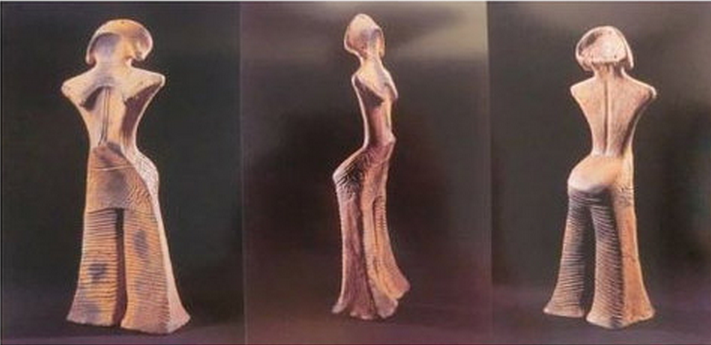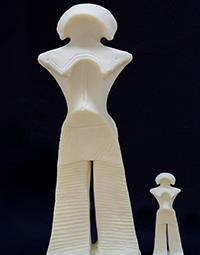Yamagata Prefecture in the southwest corner of Tōhoku faces the East Sea/Sea of Japan in an area bounded by magnificent mountain vistas.
It’s home to the Yamagata Prefectural Museum, which holds some 300,000 exhibit items in its collection, among them a 4,500-year-old clay doll from the Jōmon period (12,000 BC – 300 BC). She’s known as Jōmon-no-megami, or the Jōmon Venus.
Upon seeing the statue for the first time, avant-garde artist Taro Okamoto said, “My blood boiled to a tremendous heat and then burst into flames.”
Such figurines generally depict pregnant women, and perhaps the most famous example from this period in Japanese history is the Jōmon Venus. It’s revered for both its pristine condition and pure, sculptural beauty. Part of the statue’s appeal may lie in the fact that many of the Jōmon clay figurines were broken — on purpose — as part of ritual ceremonies devoted to curing illness or cleansing their owners of faults or impurities. Some scholars believe the figurines served as charms  to call upon the divine gods for protection. Other researchers say the figurines were female because they were made — and owned — by women intent on seeing them as symbols of reproduction and the regeneration of life.
to call upon the divine gods for protection. Other researchers say the figurines were female because they were made — and owned — by women intent on seeing them as symbols of reproduction and the regeneration of life.
The Jōmon Venus is the largest of its kind in Japan, and in 2012 was declared a national treasure. Wanting to help visitors to the museum better experience the art — even get hands-on — the museum decided to utilize Stratasys’ 3D printing technology to create replicas of the important clay figurine. Since the replicas were unveiled, their well-publicized presence has helped pack the museum with visitors. Susumu Abe, the Vice Director of the Yamagata Prefectural Museum, says 45,000 people visited during 2013 alone. Abe says the replicas provide a way for visitors to learn about the past by allowing them to touch and feel the replicas.
“History is a wonder and may seem a bit out of reach for most people,” Abe says. “But with 3D printing, we offer visitors the opportunity to interactively walk through history. …I thought that 3D printing could also be used on our collections, making these precious historical antiques more accessible, with the objectives of preserving history and educating the public on national heritage.”
In about three months, the museum had a few 3D printed replicas of the statue: a 1:1 scale replica, along with several 1:3 scale copies for use during educational events.
The project used a Stratasys Objet30 Pro 3D Printer to output the replicas.
“3D printing, a modern and innovative technique, is both preserving and changing history,” Abe said. “There are interesting ancient patterns around the waist of the goddess. It is important that we capture the details that showcase the uniqueness of the doll.”
Stratasys says the full-sized model took 20 to 30 hours to output in their rigid, opaque VeroWhite material, and that it took just three to four hours to 3D print the smaller versions.
Do you think 3D printing historical pieces like the Jōmon Venus helps people get a feel for history? Join the discussion in the 3D Printing the 4,500 Year-old Jōmon Venus thread at 3DPB.com
Subscribe to Our Email Newsletter
Stay up-to-date on all the latest news from the 3D printing industry and receive information and offers from third party vendors.
You May Also Like
Gorilla Sports GE’s First 3D Printed Titanium Cast
How do you help a gorilla with a broken arm? Sounds like the start of a bad joke a zookeeper might tell, but it’s an actual dilemma recently faced by...
Nylon 3D Printed Parts Made More Functional with Coatings & Colors
Parts 3D printed from polyamide (PA, Nylon) 12 using powder bed fusion (PBF) are a mainstay in the additive manufacturing (AM) industry. While post-finishing processes have improved the porosity of...
$25M to Back Sintavia’s Largest Expansion of Metal 3D Printing Capacity Since 2019
Sintavia, the digital manufacturing company specializing in mission-critical parts for strategic sectors, announced a $25 million investment to increase its production capacity, the largest expansion to its operations since 2019....
Velo3D Initiates Public Offering in a Bid to Strengthen Financial Foundations and Drive Future Growth
Velo3D (NYSE: VLD) has been among a number of publicly traded 3D printing firms that have attempted to weather the current macroeconomic climate. After posting a challenging financial report for 2023,...

































